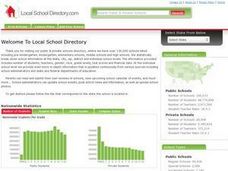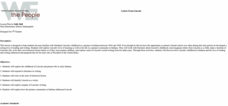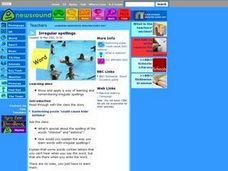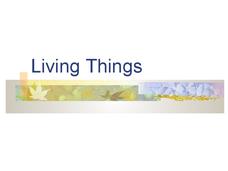Curated OER
Unscramble the Letters - Music Terms
Young scholars receive a worksheet on music terms. As a class, they unscramble a couple before attempt them on their own. They then write the meaning of each to research the meaning of the musical terms.
Curated OER
Letters from Lincoln
Fourth graders explore the childhood of Lincoln and pioneer life in early Indiana. Students respond to literature and write a story using historical fiction. Students explore the writings of President Lincoln and the pioneer community...
Curated OER
Autobiographical Writing
Second graders explore, examine and study the style of autobiographical writing and the relationship with the author. They rad three different types of autobiographical writings: narrative, poetry and newspaper article. Each student...
Curated OER
Literal Meaning of Reading
Students demonstrate literal meaning of a fiction book. In this reading comprehension instructional activity, students listen to the book, If You Give a Mouse a Muffin and practice the "m" sound during the read aloud. Students answer...
Curated OER
Swimmy Swim Swiftly
Students examine the letter 's'. Through instruction and modeling they explore the sound the letter makes, how the letter is written, words that contain the letter, etc. They listen to a story and identify words with the /s/ sound by...
Curated OER
One Word Substitution 26
In this online interactive vocabulary skills worksheet, learners match the 10 vocabulary terms in the word bank to the appropriate definitions. Students may submit their answers to be scored. All of the words begin with...
Curated OER
The Carlyle House and Gadsby Tavern
Fourth graders tour the Carlyle House and Gadsby Tavern while working on worksheets covering both places. They are to write an essay and thank you notes to finish the instructional activity.
Curated OER
Feelings From A to Z
Third graders create a class A to Z Feelings book to explore emotions, discover new words, pose for a "feeling" icture, and write about the feeling.
Curated OER
Who's in the Shed?
Second graders examine the cover of the book, WHO'S IN THE SHED? and talk about the animals portrayed and the noises they make. They then read the book as a class, looking through the peepholes and making predictions.
Curated OER
Cops and Robbers
Second graders observe the teacher model writing a letter to the author of the book, COPS AND ROBBERS. They then compare the story structure of the book to those of FUNNYBONES and identify the setting, characters and theme.
Curated OER
Final Consonant Sounds: Review - ft, ld, lt, mp, nd
These are challenging phonics review sheets. On the first page, learners match the end sounds to the pictures and write a rhyming word for each word. For the second page, pupils choose an end sound to complete a series of incomplete...
Curated OER
Scribbleboy
Fifth graders are introduced to the text, SCRIBBLEBOY, discussing the cover page for clues to the genre. They discuss the ordinary surroundings contrasted by the graffiti and the words and phrases used to provide information about the...
Curated OER
Irregular Spellings
Students know and apply a way of learning and remembering irregular spellings. Students show where irregular spellings can be found everywhere in our society today. Students tie in irregular spellings to silent letters as well.
Curated OER
The Big Sneeze
Students participate in a variety of shared reading and writing activities related to the book "The Big Sneeze" by Ruth Brown. They develop a list of farm vocabulary, sequence the events of the story on a graphic organizer, act out...
Math Worksheets Land
Represent a Fraction on a Number Line
A number line serves as the medium to display visual fractions as scholars examine two points along its segmented length. The line is split into quarters and scholars determine which fraction is represented by two letters labeled at...
Curated OER
Unit: Processing and Manufacturing: Examination Three
StudentsMatch the vocabulary terms in column A with the definitions in column B. Write the letter of the definition in column B in the space next to the terms in column A. Afterwhcich, students Write short answers or fill in the blank to...
Curated OER
The Importance of Being Flexible and Open-minded as a Visitor to Another Culture: Lesson 2 For "The Train Ride Home"
Learners examine the advantages of being flexible when visiting or living in a different culture. They read and discuss a first-hand account by a Peace Corps volunteer in Kazakhstan, and write a letter from the point of view of a...
Curated OER
Lights, Camera...Ticket...2
Students research the pros and cons of traffic light cameras that generate tickets and interview local city officials to see if they have considered this for the community. Students then prepare a panel to present the advantages and...
Curated OER
University of the State of New York: Grade 4 Science Test
In this New York University grade 4 science test, 4th graders complete 40 multiple choice questions covering a wide range of grade 4 science concepts.
Curated OER
Suffixes
Many words have suffixes, and knowing them can help scholars with vocabulary and spelling. They read a brief introduction explaining suffixes and giving two examples: -ly and -ful. Then, learners add these suffix examples to seven base...
Curated OER
Macbeth: The Basics
Just as the title states, this quiz covers basic questions related to Shakespeare's The Tragedy of Macbeth. Test your learners' knowledge with 10 multiple-choice questions. Answers appear when you submit online.
Curated OER
Sleuthing A Writer's Skills
Learners read The Train Ride Home by Robin Solomon. In this literature response lesson, students will inspect the writing of Solomon to determine how she established a certain tone through her word choice and paragraph structure....
Curated OER
Living Things
Alive or not? After viewing this presentation, life science learners will know how to answer this question. They are introduced to the seven processes of living systems and the classification hierarchy. Because it only covers...
Curated OER
Number Lines and Whole Numbers
Number lines come in handy once again! Use them to help scholars visualize addition and subtraction problems. They examine five lines to determine which equation each represents, then match them to a list of answers. Consider covering...

























